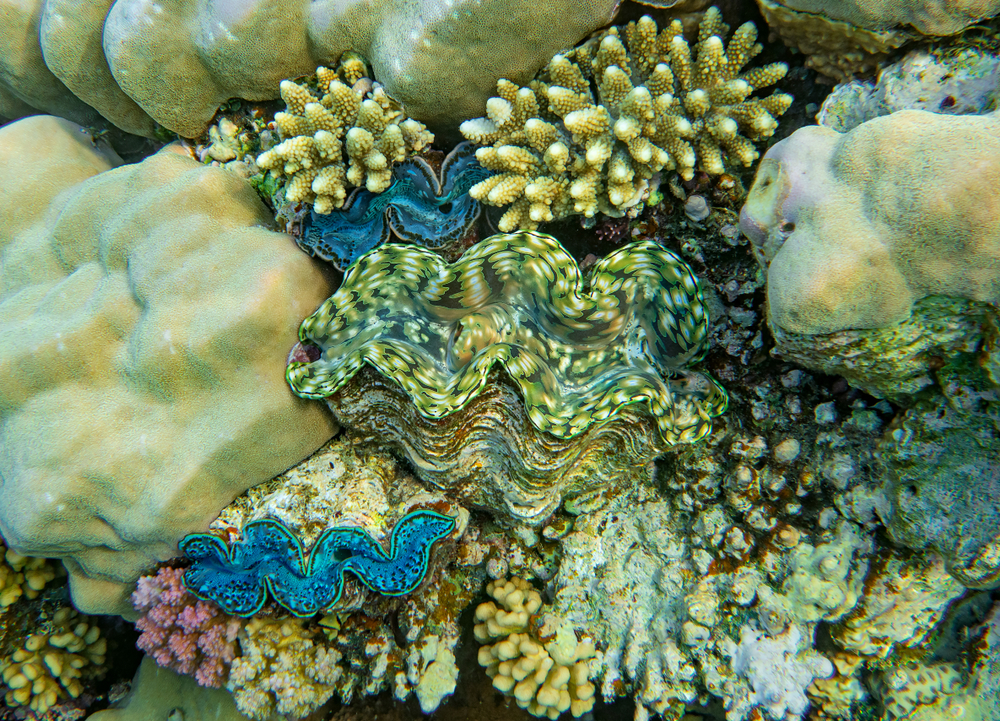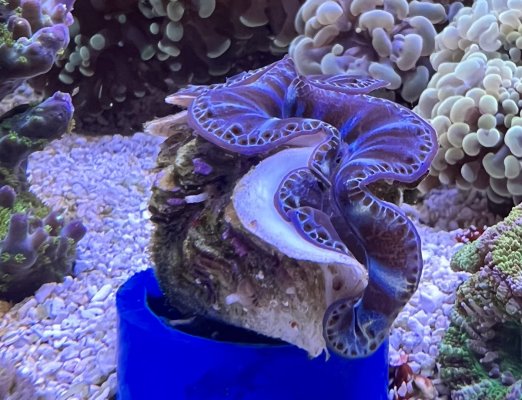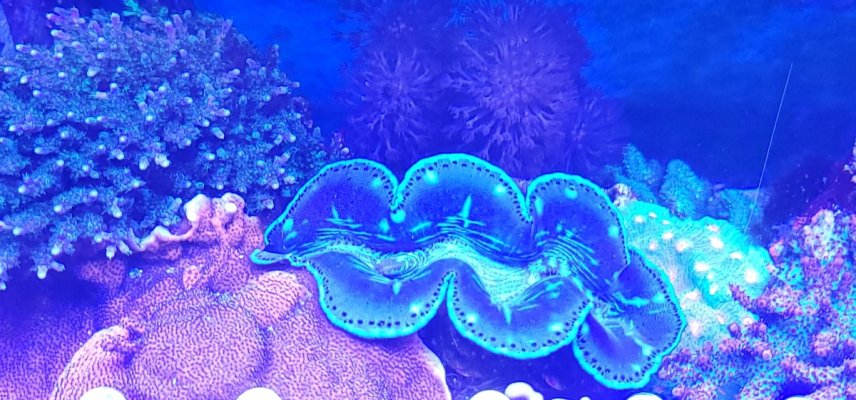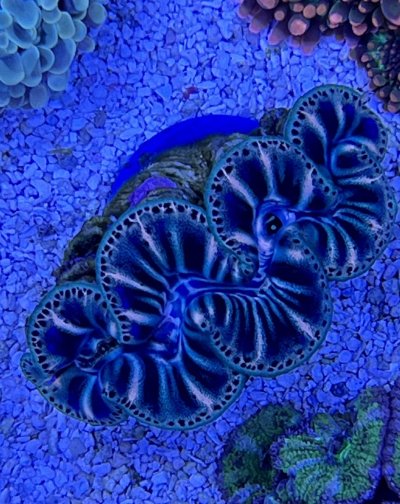I would check for pests, pyramid snails, vermitid snails on the shell, aiptasia, etc... Also, that striped hermit crab is a no-no in a reef, especially clams. I wouldn't say PMD unless the mantle is recessing more each day? If it's just that lobe of the mantle, I would look for something irritating it. Also, feed the tank, not the clam. Feeding clams is unnecessary, but providing them with nitrogen via phyto is okay. I would increase lighting intensity to achieve 250+ micro moles, 150 isn't going to cut it for very long. Just make sure you're seeing new shell growth underneath the mantle's upper margins. I would find a spot on the rockwork higher up, which is where maximas should be placed anyway.
Navigation
Install the app
How to install the app on iOS
Follow along with the video below to see how to install our site as a web app on your home screen.
Note: This feature may not be available in some browsers.
More options
You are using an out of date browser. It may not display this or other websites correctly.
You should upgrade or use an alternative browser.
You should upgrade or use an alternative browser.
Something seems off with my clam
- Thread starter HouseofStark
- Start date
- Tagged users None
Algae barn recommends 250-500 par. Anything less, clams would have to be fed and above that par, they would do exceptional.

 www.algaebarn.com
You should up your par, but it's not a "death sentance" if fed. I kept mine in about 175~200 for 5 years or so. I just recently (this past month) uped my par to 330.
www.algaebarn.com
You should up your par, but it's not a "death sentance" if fed. I kept mine in about 175~200 for 5 years or so. I just recently (this past month) uped my par to 330.

Keeping Clams in the Reef Tank
I remember getting about six months to a year into this hobby, thinking I knew everything about proper water parameters, lighting, dosing, and keeping a
 www.algaebarn.com
www.algaebarn.com
Attachments
Phyto can help, but it will never keep a clam alive without proper lighting. It's a great source of nitrogen for clams, but remember, they don't always eat what they take in, a lot of things will simply pass through the animal without it utilizing it at all. A better way to use phyto is to feed the tank as it will increase the food chain, which will help feed other animals, including clams, but do feed the clam lots of full spectrum lighting. To help you understand this better, there was a study that separated clams into two isolated vats and provided them with the same lighting, but one was fed phyto and the other didn't get phyto. There was virtually no difference in growth between the two when the study was concluded. People need to drop the "clams need phyto" as a requirement for keeping them. It's the wrong way of thinking when keeping them, but do consider feeding your tank phyto, as it can be a great catalyst for increasing the diversity of your food chain.Algae barn recommends 250-500 par. Anything less, clams would have to be fed and above that par, they would do exceptional.
You should up your par, but it's not a "death sentance" if fed. I kept mine in about 175~200 for 5 years or so. I just recently (this past month) uped my par to 330.
Keeping Clams in the Reef Tank
I remember getting about six months to a year into this hobby, thinking I knew everything about proper water parameters, lighting, dosing, and keeping awww.algaebarn.com
I do encourage people who are experienced and new to keeping clams to buy both books by James Fatherree, it will help you in so many ways.
To the OP, I would increase your intensity, but I would encourage you to move the clam to a more suitable location in the rockwork, as this is where maximas and croceas are found. A clam cradle isn't going to cut for very long. Maximas get big, 12" +
James' first book James' second book
Let me be perfectly clear. I was responding to the post that "its a death sentance in 150 par". I thought that was a little harsh to write and I personally don't believe it to be true. I have kept mine in sub 250 for years and it didn't die.Phyto can help, but it will never keep a clam alive without proper lighting. It's a great source of nitrogen for clams, but remember, they don't always eat what they take in, a lot of things will simply pass through the animal without it utilizing it at all. A better way to use phyto is to feed the tank as it will increase the food chain, which will help feed other animals, including clams, but do feed the clam lots of full spectrum lighting. To help you understand this better, there was a study that separated clams into two isolated vats and provided them with the same lighting, but one was fed phyto and the other didn't get phyto. There was virtually no difference in growth between the two when the study was concluded. People need to drop the "clams need phyto" as a requirement for keeping them. It's the wrong way of thinking when keeping them, but do consider feeding your tank phyto, as it can be a great catalyst for increasing the diversity of your food chain.
I do encourage people who are experienced and new to keeping clams to buy both books by James Fatherree, it will help you in so many ways.
To the OP, I would increase your intensity, but I would encourage you to move the clam to a more suitable location in the rockwork, as this is where maximas and croceas are found. A clam cradle isn't going to cut for very long. Maximas get big, 12" +
James' first book James' second book
I also did say he should up his par from 150 because, yes, it is low. But if his tank is on the dirtier side or does supplement with food it will be okay. It's not much less than I kept mine in. Also, if the clam is on the smaller side, too much light is as bad as not enough per the link I presented.
Happy reefing!
Yeah, I didn’t want to say it’s a death sentence, but did want to point out that these clams are found in shallow water and you’ll never be able to give them too much light. Having said that, you can give them light shock if provided too much light at first if they are coming from a lower light tank/situation. Acclimating them to higher light over the course of a few weeks is safer. I will absolutely disagree about “feeding” clams though and I’ll point out that they need strong lighting from the start. All tridacna clams that we keep come fully assembled with all of the zooxanthellae necessary to sustain themselves from only a few millimeters long. The only exception is T. gigas, when first established/settled, they actually require food until their mantle is populated with zooxanthellae. That’s not the case with other tridacnas.Let me be perfectly clear. I was responding to the post that "its a death sentance in 150 par". I thought that was a little harsh to write and I personally don't believe it to be true. I have kept mine in sub 250 for years and it didn't die.
I also did say he should up his par from 150 because, yes, it is low. But if his tank is on the dirtier side or does supplement with food it will be okay. It's not much less than I kept mine in. Also, if the clam is on the smaller side, too much light is as bad as not enough per the link I presented.
Happy reefing!
If certain clams are kept in lower light, but with a longer photo period, that can make the difference in their longevity and is usually the case in lower par (micro moles) situations. For maximas and croceas to be successful long term, they need to be “secured “ in rock or a nice solid surrounding and provided with very strong full spectrum lighting. If not, they will starve to death, the length of time that takes depends on the size of the animal and the light provided.
Also, I’m only trying to help and was responding in general and not directing certain comments to you. I see a lot of people here and other forums post about clams (and other animals) that they just acquired without having any experience with them or make any attempt at researching their unique care requirements before buying them. Clams are vastly different to the other animals (corals) we keep and are very complex. Too often people put clams in tanks and adjust their lighting based on the other animals in the tank, when it should be the other way around. You should light the clams and add animals that would fit around the clams. I will always tell people to feed their tanks, not their clams (or corals) unless those particular animals require direct feeding, which clams do not. Clams do require nitrogen and phosphorus, but they don’t require phyto, which is often associated with clams. I will always advocate strong lighting first with clams, then providing them with N&P next, which is usually supplied by just feeding your fish.
Happy Father’s Day and happy reefing!
- Joined
- Nov 15, 2018
- Messages
- 160
- Reaction score
- 66
Good to hear/see. Most likely a neighbor not being so neighborly.
- Joined
- Nov 15, 2018
- Messages
- 160
- Reaction score
- 66
Hoping it was easy as thatGood to hear/see. Most likely a neighbor not being so neighborly.
the “death sentence” at 150 PAR is a paraphrase from James Fatheree. If anyone has a maxima growing well for years under 150 PAR, that’s by far the exception rather than the rule.
I also see a couple vermetid snail tubes near where the mantle is retracted. I'd crush them, it doesn't take much, as their mucus net can irritate things.I’ve had this maxima in the same spot for about 2 months now, noticing one of the lobes on the mantle doesn’t fully extend over the previous clam shell. I asked the seller if this was a sign of a pinched mantle, he said no looks healthy just let it be. What do you guys think? The rest of the clams mantle is fully extended, and looks like it should.


















